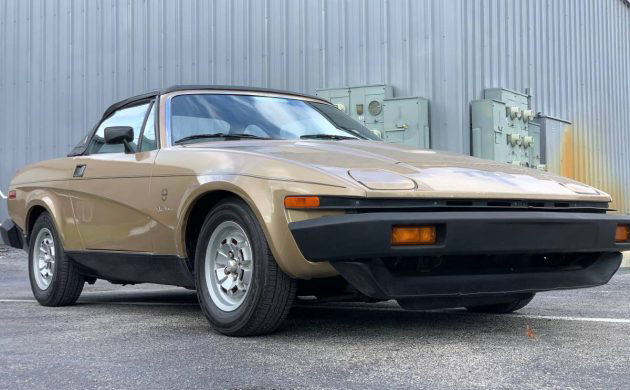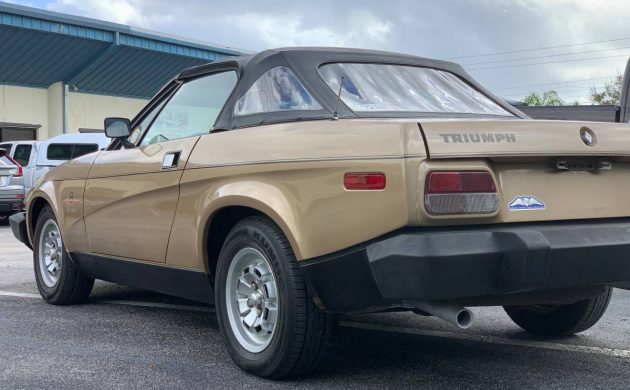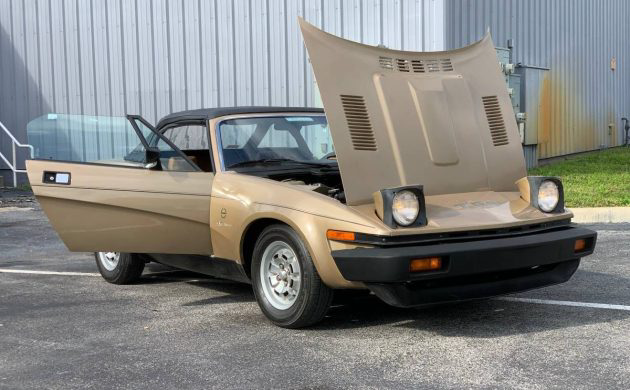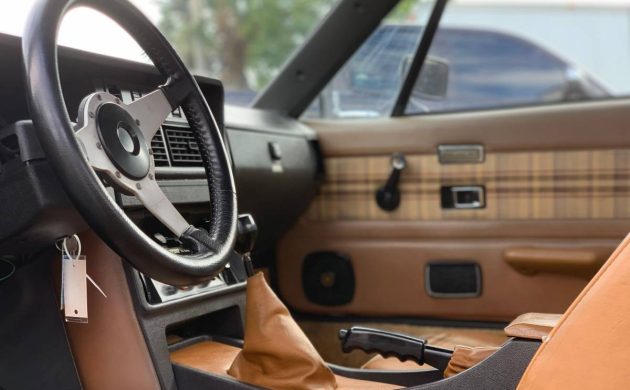By the time Triumph finally offered a TR7 to a waiting world, many factors had come into play that made the car an iffy proposition from the start. Before the car made it into the hands of waiting customers, issues such as a poor exchange rate, labor troubles at the factories, insanely incompetent management by British Leyland, and quality control issues had soured many potential customers for the radically new car. Even cars fitted with a V-8 engine like this 1981 Triumph TR8 for sale on Craigslist in West Palm Beach, Florida had trouble finding their way off dealer lots. Was any of this fair? Were the TR7s and TR8s better than their reputation tells us? Thanks to PRA4SNW for the tip on this rare Triumph!
The Triumph TR7 was launched in Great Britain in September of 1974, with its American debut in January of the next year. As an intended successor to the traditionally styled, hairy-chested TR6, it was quite a departure. With a radical wedge shape and a large increase in the number of plastics used inside and out, the car was almost from a different planet. However, it was from Triumph, which was then a captive marque of the conglomerate British Leyland.
British Leyland was a company that was made up of several storied British brands that had been gobbled up Pac-Man style. While many of those brands were unique and worth saving, putting them all together in the same company was madness. There were so many cases of overlapping markets to the point that a product on one side of the house was in direct competition with another on the other side, and there just wasn’t enough of a market to support both. Thus, sales and development suffered for both hammering the company bottom line.
Add to that the fact that British Leyland was partially nationalized in 1975. While any outside observer would have recoiled in horror at the prospect of adding government inefficiency to this dog’s breakfast of a company, nonetheless it was implemented. Part of the reason was to keep people employed during these dark economic times. Another factor in play was the monumental struggles between incompetent management and disgruntled workers. As you can imagine, quality plummeted in an era when the Japanese were setting new standards in quality control.
With all of these problems taking their toll on the new TR7, one of the most serious was the exchange rate. By that time, the American market was wildly important to British Leyland. Exchange rates had become increasingly unfavorable, driving the price of the company’s cars up dramatically. The issues with build quality were also harming sales. While some of that reputation was not warranted given the times and the products of other makers, the last thing that British Leyland needed were more nails in their coffin.
One way that Triumph countered these issues was to cram an aluminum 3.5 liter V-8 from Rover into the car. This engine was a direct descendant of the excellent small V-8 that Oldsmobile and Buick developed in the early sixties and subsequently sold the rights to. The engine was a perfect fit for the car and performed well. After a trial run of semi-prototypes, the V-8-powered version reached full production by late 1978 and ran until 1981. Despite the car’s promise, the forces working against it ended up limiting sales to a guestimated 400 coupes and 2,750 convertibles. Almost all were sold in North America.
The car you see in the pictures is one of the last of the TR8 vehicles produced before the 1981 end of the model. While the seller tells us the bare minimum about the car, we can see that there are some issues to be attended to. A glance at the pictures shows panel alignment can be worked on and something is missing from the fuel injection system. However, those issues do not appear to be insurmountable, and the car’s overall condition is stated to be like new in the ad. With an advertised 46,754 miles, perhaps those issues have kept its condition good by keeping it off the road.
It is a manual transmission car, and road tests performed during the car’s heyday confirm that they were capable of going from 0-60 in about 8.5 seconds. While that is not a great number today, back then it was quite respectable. If someone repaired the front bumper, replaced whatever happens to be missing from the fuel injection unit, and went around the car making repairs and tightening up the cosmetics, this may end up being a great car.
Should an end user have to do all this work on a car that has so few miles? No, but that is one of the reasons buyers drove past Triumph dealers without stopping in the end. It was a good car design with a competent engine that maybe didn’t deserve all of its reputation. All things considered, it was amazing that the TR8 was as good as it was considering all that it had going against it.







As a kid these were cool-conceptually anyway-but as you’ve perfectly explained it was a good idea born to bad circumstances.
This one has potential for someone with access to or good knowledge of bodywork and mechanical (electrical?) problems sorting though the price is too high for its condition.
Once it’s fixed it’d be a blast to drive-but getting it at the right price might be a tough negotiation.
Was in Norway from ’74 to ’77 working with British military and listening to the collapse of British Leyland and the rest of the country’s automotive manufacturers. Jeff well covered the details of what went on but left out the feelings of the country’s workers and other affected people. The Brits I worked with all had friends and relatives directly affected by the whole mess and told stories that were heartbreaking. Amazing BL was even able to get the TR8 out at all. That said, got a pure car guy friend who has one and he said it’s a rip to drive.
Jeff, I think what’s missing is the air filter(s) for the two Stromberg(?) carbs. Don’t remember the F.I. looking like that….
As for the rest, I’ve owned several British cars, and have driven more, and don’t think any of the issues visible are too awful. These are pretty attractive to me, certainly more so than the ungainly coupes.
Don’t know about the price. ALL prices seem to high to me these days. In any case, it’s a down payment, as there are sure to be service calls, parts replacements, and/or weekends in the driveway with tools ahead.
But bobhess’s car-guy friend is spot-on. these are fun to drive!
I was thinking the same thing, that those Strombergs don’t look like Bosch K-Jetronic fuel injection! I think that only CA cars got EFI, until the last model year, at least. If synchronizing the dual Strombergs isn’t your thing, Edelbrock makes an aluminum intake manifold for a four-barrel carburetor for that Rover/BOP 215 V8.
The stylings polarizing to be sure. Some people love it, some people hate it, but there aren’t too many fence sitters. I like it, but lots of people don’t, and that’s O.K., to each his own.
Where I feel that these cars are a step backwards, IMHO, is the suspension. The unibody construction was replacing the TR-6’s body-on-frame architecture, which isn’t my favorite, but where they really blew it was ditching the TR-6’s IRS setup in favor of the cheaper, but much less capable solid axle in the back. The price went up, but the handling went down, not a good combination in anybody’s ledger.
Watched some old swedish rally races the other day. Footage of one of these in it. Had a wicked exhaust note. Might be fun with a 5speed. Does seem a bit pricey.
They ARE 5 spds. I own one exactly like it – except for my Eldelbrock 4bbl. and A/C.
NOTE: a TR8 is NOT a Sunbeam Tiger. The Tiger is a much less complicated machine, – more raw and faster. I had one and wish I had it back. It was a rip.
Ray is correct, those are Stromberg carbs and apparently the air cleaner bandit hits them all. The air cleaners were a box type on either side, or a big tin can in the back. I read, a GM throttle body F.I. is a common swap. The TR7/8 sure got the crappy end of the stick. British purists, me included, were horrified that THIS is what replaced our beloved Triumph TR6. I know, the Brits can display some outside the box thinking, but when it came to traditional British cars, this was too far out there. 115,000 TR7s were made, including only 2800 TR8s, most, if not all were sent to the USA. The V8 was a hefty chunk of cheese, Americans and their V8s and all, and I bet an absolute BLAST to drive, all quiet on the western front. I read, these cost a whopping $11-$14,000, almost double what a TR6 cost. And we thought only Chrysler made risky gambles. A shame, as today this looks like a really fun car for $9500? Should have been gone long ago.
That “hefty chunk of cheese” is actually about 20 kgs lighter than the cast iron 4 cylinder it replaces lol
I don’t know about the TR7 2l 4 cylinder weight, but yes, this engine is lighter than the B series engine of the MGB.
A Google search puts the b series at 335, the v8 at 318 and the slant 4 at 290
By “cheese”, I didn’t mean weight. The V8 was the “cheese” and was the bait to lure Americans in.
I was a student in UK in these times. The TR7 was just embarassing. Most things were in the UK at the time so I chose a career which got me gone.
We sold our 1971 MGB and purchased a 1975 TR7 (4 cyl/manual) convertible. It was absolutely the worse vehicle we’d ever owned. The dash was entirely composed of hard plastic pieces. The body panels were misaligned. Fabrics (like the carpet and soft top) disintegrated in short order. Sold it at a huge loss and replaced it with a 1976 Pontiac Firebird. Just looking at these photos brought back memories that made me shudder.
Consider the needs and optimum market value, the pricing is quite high. I suggest under $5K would be fair in this case. Just sayin’
46,754 miles !! Actually that is quite impressive for a TR8.
Replying here because my page doesn’t show a general reply box (hi Azzura).
As noted this car has Zenith Stromberg carbs as shown quite clearly in the pictures, you even see the innards of the carb (the piston, because air cleaner is MIA).
The TR7/8 is an interesting story, not near as awful as many state, but not quite there.
The early cars had what was basically a Spitfire 4 speed, a transmission arguably not up to the task for the bigger, more powerful TR, also a lot of sports cars were getting five speeds by then. As I recall they also had problems with the (electronic?) ignition system, and build quality from the initial production run was not good. As production went on quality went up, and you got five speeds and a convertible a available. But the early cars reputation killed the later car’s sales, and by the time the TR8 came out it was too little too late.
The TR7 was a much better handler out of the box than a TR6, despite not having IRS, but the less sophisticated suspension in spec (it has a lot more travel than the TR6 though) was still seen as a mark against it by some, though it didn’t seem to hold Mazdas RX7 back.
Anyway, the sold a lot of them, more than they sold TR6’s, they had a great media blitz with the shape of things to come. I knew non-car people or marginal car people who thought it was cool.
But most of the sales were early, when the cars weren’t at their best, they got a bad reputation, and the convertible and V8 came too late to save it.
I agree in general with the points you made, but I should point out that only the first-generation RX-7 (1978-85) made do with a solid rear axle. The second-generation cars (1986-92) and third-generation cars (1991-97) got fully-independent rear suspensions as standard equipment. The solid-axle setup was fairly sophisticated, with coil springs, trailing arms and a Watt’s Linkage, but still, the limitations of the solid axle were well known, and Mazda finally moved beyond it. Source: Wikipedia.
https://en.wikipedia.org/wiki/Mazda_RX-7
As usual, there are lots of denigrators that have never driven one or perhaps ever carefully looked one over, I have had one along with a bunch of other TR’s and this is the BEST of all! Kasner –as usual took one to the top at the SCCA finals, they of course respond well to a small holly and headers, parts are easy–the engine USED TO BE IN AMERICAN CARS as well as Rover and others, lots of testing and hop up was done when they came out and they were found to be bullet proof.There’re lots of 7’s around for parts. That so few were made insures they will appreciate as”classics”! Get one while they haven’t gone through the ceiling money wise!
That “fuel injection system” is a couple of Zenith-Stromberg carburators… This car could actually be a great deal but you could never tell from that ad. Under 50k mi… If the body is clean (no rust) and the engine runs well, I wouldn’t hesitate to pay the ask. TR8s are wonderful cars to drive…
There IS a real honest to goodness fuel injection system that came to California, the Stromberg system was required at first for SMOG~~ I’ve never seen either prepped but they’re both not bad and could produce decent Horsepower, it’s just that Americans don’t understand Strombergs OR the fuel injection so prefer the stone simple Holly, Casner I re
call got his winning power from the Strombergs I think both the Tiger and the TR-8 ran in B-p so it would be interesting to look at their competition histories
This from https://en.wikipedia.org/wiki/Triumph_TR8
“History has shown this engine to be an extremely reliable, flexible, and robust powerplant, especially after BL developed a better manufacturing process. TR8s were initially fitted with twin Zenith-Stromberg carburetors. However, about 400 1980 models sold in California, all 1981 models—of which only 352 were produced including twenty carbed cars for the UK market—and all 1982 models (of which all seventy went to Canada)[9] featured a Bosch L-jetronic fuel injection system with a specially designed Lucas fuel injection computer (ECU).[10] The 1980 carburetor model was rated at 133 bhp (99 kW; 135 PS) (at 5000 rpm) and the fuel injected California version at 137 bhp (102 kW; 139 PS) at the same engine speed.[11] For 1981, all North American cars received a unified version with fuel injection, producing 148 bhp (110 kW; 150 PS) at 5100 rpm and delivering 0–60 mph times in the low 8 seconds.[12][13] Other differences between the TR8 and TR7 are upgraded brakes, revised axle ratio (3.08:1 on the TR8 and all automatic TR7s), battery moved to the trunk (boot), alloy wheels, leather steering wheel and a few minor trim changes.”
It sounds like this car should have FI… but has carbs instead? Is it really an ’81? Maybe sold a year late? Maybe swapped from FI to carbs?
It sounds like a “birth certificate” from BMIHT, may be necessary.
If they swapped from fuel injection to carbs you would think it might be to a Holley conversion rather than those emissions Stromberg’s, but sometimes you may get have a parts car laying around or swapped in a whole engine, or year of the car isn’t properly represented.
Excuse my ignorance, but does BMIHT stand for British Motor Industry Heritage Trust?
All US 1981 TR8s were fuel injection, this has the two carbs, the cloisonne badge is missing from the nose, 1980 models had the decal. I really don’t think this is a 1981 model.
Nice TR8 Just testing to see if l’m connected.
Little doubt it’s a 1980. The 1981 with the fuel injection is the one to have IMO. Interior suggests low miles, but not enough good pictures to have confidence. Speedo cables broke often on many of these. Airco in these can be good enough for Florida heat. I’d guess the dealer got it from an estate.
I believe you are correct sir. I worked at a Jaguar-Rover-Triumph dealership in Calgary in early-to-mid 1981, when JRT had knocked $2000 off the price of all of their new Triumphs and MGs. (new TR8s came down from $17,500 CDN to $15,500. New TR7s came down to $10,500 and new Spitfires were down to $9500). I got to drive these beasts, my favourite being a British Racing Green TR8 with tan upholstery, a Holley 650 dual-pump mod and headers. The 1980 TR8s had the decal on the nose rather than the medallion that was used on the ’81s. The 1980 also had the plaid door and seat inserts and the same tall(er) shift lever as the TR7. But for ’81 Triumph went with crushed-velour seat and door panel inserts and a shorter shift lever. I believe they also thickened the steering wheel rim padding for ’81, but I could be wrong about that. The car in this ad is definitely an ’80, not an ’81.
I remember that MGs were titled according to the year sold rather than the year built. Possibly an ’80 sold in ’81?
Responding to TouringForDor: it’s certainly possible that a few of the 1980 TR8s could have been registered in certain jurisdictions as ’81 models if sold in that year rather than in 1980. But, unlike the MGs of those same two model years, the ’81 TR8s had some definite cosmetic changes that distinguished them from the ’80 models. This in theory should have made it harder for dealer networks to pull the wool over the eyes of its customers – if indeed this was what they were attempting to do.
Just dug up the following article regarding production of the TR7 and TR8. Lots of info that perhaps explains the model year question. It appears all of the ’81 cars (which were identified by the badge rather than the decal) were built in the Solihull (Rover) factory while all of the mid-’78 through late 1980 cars were built in Coventry at the Canley facility. (The quality-and-morale-plagued Speke factory was shut down in spring of 1978, so no TR8s would have come out of there):
http://www.team.net/TR8/history/wedgehis2.html
In the mid-1980s, I had a 1980 TR7, I brought from my brother. It was BRG and had a tan crushed velour interior, no plaid anywhere.
I do recall in 1981 driving a brand new TR7 (Stromberg, same as the TR8) back to the dealership after receiving a customer-ordered set of pin stripes – only to have the throttle cable snap three blocks before arrival. Limped the rest of the way there at idle. During the beginning of rush hour. On a Friday. And it was uphill both ways…..
Saw one of these two days ago in Eugene and I was pleasantly surprised to hear that it was a TR8. Nice little cars, but I never cared for the shape. The TR6 that proceeded it will forever be a beautiful car.
Even though this car lives in CA now, some of the pictures when zoomed into the lower door panel and wheel arches look a bit like poorly repaired rust.
Could just be low res images, but I would bring a magnet/bondo checker when inspecting, just to be sure.
I love Triumphs, I’ve had a few, they do have their issues. That being said, a guy I worked with bought one of these brand new. It broke non-stop, we had to tow him back to the shop weekly. This I feel is the worst of the worst. While British Leyland produced many great cars, when their economy sank so did everything else. Hyper inflation during those years. In 1972 I could get a 3 piece fish and chips for 33 cents american, in 1976 it was 3 times that much.
I respect Leyland for what they had and what they built, but that was the end, just like this TR listed here. Cheers,
I have owned 50+ cars including a Triumph Spitfire, TR 6, and a TR 7, undoubtedly the worst car I have ever owned.